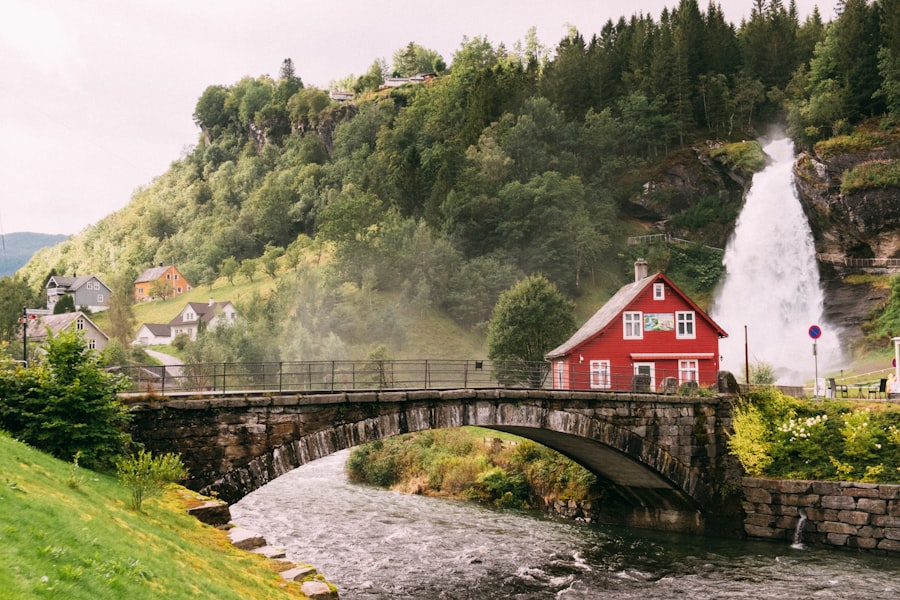Cycling in Norway is not merely a mode of transport; it is a way of life that intertwines with the country’s stunning landscapes and vibrant culture. With its breathtaking fjords, majestic mountains, and picturesque villages, Norway offers an unparalleled backdrop for cyclists of all levels. The nation boasts an extensive network of cycling paths and trails, making it an ideal destination for both leisure riders and serious cyclists.
From the bustling streets of Oslo to the serene countryside, cycling provides a unique opportunity to explore the natural beauty and rich heritage of this Scandinavian gem. Moreover, cycling in Norway is deeply ingrained in the local lifestyle. Many Norwegians rely on bicycles for their daily commutes, contributing to a healthier population and a more sustainable environment.
The government actively promotes cycling as a viable alternative to driving, investing in infrastructure that supports safe and enjoyable cycling experiences. As a result, the cycling culture in Norway is not only thriving but also evolving, with an increasing number of people embracing this eco-friendly mode of transport. Book your 1-hour strategy session with Norway Relocation Group.
Summary
- Cycling is a popular mode of transportation in Norway, with stunning landscapes and well-maintained cycling paths.
- Understanding and following the rules of the road is essential for safe cycling in Norway, including traffic signals and right of way.
- When sharing paths with pedestrians, cyclists should give them the right of way and use a bell or verbal signal when passing.
- Interacting with motorists requires cyclists to be assertive, visible, and predictable, while also respecting their space on the road.
- Navigating roundabouts and intersections safely involves understanding the correct positioning and using hand signals to communicate with other road users.
Understanding the Rules of the Road
To ensure a safe and enjoyable cycling experience in Norway, it is crucial to understand the rules of the road. Norwegian traffic laws are designed to protect all road users, including cyclists, pedestrians, and motorists. Cyclists are required to adhere to the same traffic regulations as vehicles, which means obeying traffic signals, stopping at red lights, and yielding to pedestrians at crossings.
Familiarising oneself with these rules is essential for both safety and compliance. In addition to general traffic laws, there are specific regulations that pertain to cyclists. For instance, wearing a helmet is strongly recommended, although it is not mandatory for adults.
However, children under the age of 15 are legally required to wear one while cycling. Furthermore, cyclists must use designated bike lanes whenever available and should be aware that riding on sidewalks is generally prohibited unless explicitly allowed. Understanding these rules not only enhances personal safety but also fosters a culture of respect among all road users.
Sharing Paths with Pedestrians

One of the key aspects of cycling in Norway is the need to share paths with pedestrians. Many urban areas feature shared pathways where cyclists and walkers coexist, necessitating a mutual understanding and respect for each other’s space. Cyclists should always be vigilant and considerate when navigating these shared spaces, ensuring they do not endanger pedestrians or disrupt their enjoyment of the path.
When approaching pedestrians, it is advisable for cyclists to slow down and give clear signals of their presence. A gentle bell ring or a polite verbal cue can go a long way in alerting pedestrians without startling them. Additionally, maintaining a safe distance while passing is essential; cyclists should always be prepared to stop if necessary.
By fostering a spirit of cooperation and courtesy on shared paths, both cyclists and pedestrians can enjoy their respective activities without conflict.
Interacting with Motorists
Interactions between cyclists and motorists can often be fraught with tension, particularly in busy urban environments. However, understanding how to navigate these interactions can significantly enhance safety for all parties involved. Cyclists should always remain visible to motorists by using lights and reflective gear, especially during low-light conditions or inclement weather.
This visibility is crucial in ensuring that drivers can see cyclists well in advance, allowing for safer manoeuvres. Moreover, it is important for cyclists to position themselves correctly on the road. Riding in a straight line and avoiding sudden movements can help motorists anticipate a cyclist’s actions.
When turning or changing lanes, cyclists should signal their intentions clearly and check for any vehicles in their blind spots. By adopting these practices, cyclists can foster a more harmonious relationship with motorists, ultimately contributing to safer roads for everyone.
Navigating Roundabouts and Intersections
Roundabouts and intersections can be particularly challenging for cyclists due to the complex interactions between various road users. In Norway, cyclists are generally expected to yield to traffic already in the roundabout; however, this can vary depending on local regulations. It is essential for cyclists to approach these areas with caution and awareness, ensuring they understand the specific rules that apply.
When navigating intersections, cyclists should always be prepared to stop if necessary. It is advisable to make eye contact with drivers when possible, as this can help establish mutual awareness. Additionally, using designated bike lanes or markings can provide guidance on where to position oneself when approaching an intersection.
By being proactive and attentive at roundabouts and intersections, cyclists can significantly reduce the risk of accidents.
Using Hand Signals and Communication

Effective communication is vital for ensuring safety while cycling on Norway’s roads. Hand signals are an essential tool for cyclists to convey their intentions to other road users. Simple gestures such as extending an arm to indicate a turn or stopping can help prevent misunderstandings and accidents.
It is important for cyclists to practice these signals regularly so they become second nature when navigating busy streets. In addition to hand signals, verbal communication can also play a role in enhancing safety. A friendly shout or bell ring can alert pedestrians or other cyclists of one’s presence, particularly in crowded areas or shared paths.
By fostering open lines of communication with fellow road users, cyclists can create a more cooperative environment that prioritises safety and consideration.
Respecting the Environment
Norway’s natural beauty is one of its most cherished assets, making it imperative for cyclists to respect the environment while enjoying their rides. This includes adhering to designated paths and trails to prevent damage to sensitive ecosystems. Cyclists should also be mindful of littering; carrying out any waste generated during rides is essential for preserving the pristine landscapes that attract so many visitors.
Furthermore, being aware of wildlife is crucial when cycling through rural areas or national parks. Animals may cross paths unexpectedly, so maintaining a safe speed and being vigilant can help prevent accidents. By respecting the environment and its inhabitants, cyclists contribute to the sustainability of Norway’s natural beauty for future generations.
Being Mindful of Weather Conditions
Norway’s weather can be unpredictable, with conditions changing rapidly throughout the year. Cyclists must be prepared for various weather scenarios, from sunny days to rain or even snow in winter months. Dressing appropriately for the weather is essential; layering clothing can help regulate body temperature while ensuring comfort during rides.
In adverse weather conditions such as rain or snow, cyclists should exercise extra caution. Reducing speed and increasing stopping distances are vital for maintaining control on slippery surfaces. Additionally, using lights and reflective gear becomes even more critical during low visibility conditions.
By being mindful of weather conditions and adjusting riding habits accordingly, cyclists can ensure their safety while enjoying Norway’s diverse climate.
Bicycle Maintenance and Safety
Regular bicycle maintenance is crucial for ensuring both performance and safety while cycling in Norway. Cyclists should routinely check their brakes, tyres, and gears before embarking on any ride. Keeping tyres properly inflated not only enhances performance but also reduces the risk of punctures on rough terrain.
Additionally, ensuring that brakes are functioning correctly can prevent accidents caused by sudden stops. Investing in quality safety equipment is equally important. A well-fitted helmet can significantly reduce the risk of head injuries in case of accidents.
Furthermore, using lights and reflectors enhances visibility during low-light conditions, making it easier for other road users to see cyclists. By prioritising bicycle maintenance and safety gear, cyclists can enjoy their rides with peace of mind.
Tips for Cycling in Urban Areas
Cycling in urban areas presents unique challenges that require specific strategies for success. One key tip is to plan routes ahead of time; using maps or cycling apps can help identify bike-friendly paths that avoid heavy traffic zones. Additionally, being aware of peak traffic times can help cyclists choose optimal times for riding.
Another important consideration is parking; finding secure bike parking facilities can prevent theft and damage while allowing cyclists to explore urban areas freely. Many cities in Norway offer designated bike racks or secure storage options near popular destinations. By taking these factors into account, cyclists can navigate urban environments more effectively while enjoying all that Norway’s cities have to offer.
Promoting Safe and Considerate Cycling
In conclusion, promoting safe and considerate cycling practices is essential for fostering a positive cycling culture in Norway. By understanding the rules of the road, sharing paths respectfully with pedestrians, interacting courteously with motorists, and being mindful of environmental impacts, cyclists can contribute to a safer experience for everyone involved. As cycling continues to grow in popularity across Norway’s cities and countryside alike, educational initiatives play a vital role in encouraging responsible behaviour among all road users.
The NLS Norwegian Language School in Oslo offers courses that not only teach language skills but also promote cultural understanding—including aspects related to cycling etiquette in Norway. By equipping individuals with knowledge about local customs and regulations through these courses, NLS helps cultivate a community that values safety and respect on the roads. Ultimately, embracing these principles will ensure that cycling remains an enjoyable activity that enhances both personal well-being and environmental sustainability in Norway’s beautiful landscapes.
Speak Norwegian with confidence. Enroll in a class at the NLS Norwegian Language School now.

